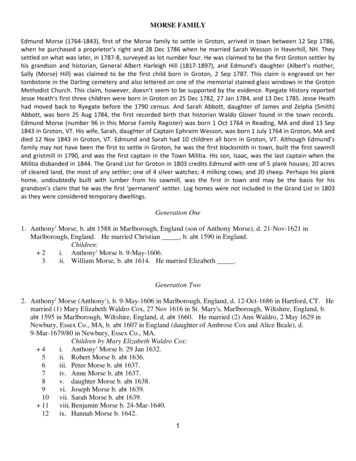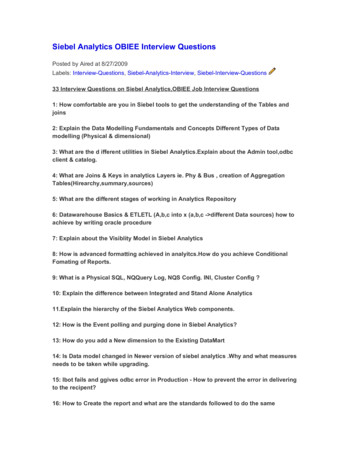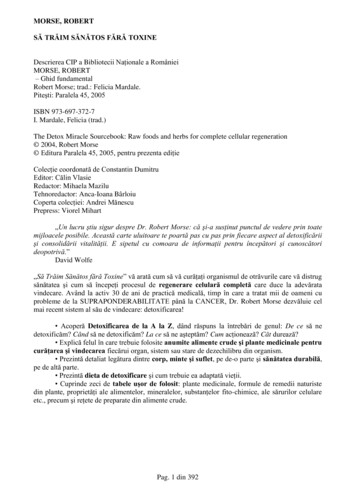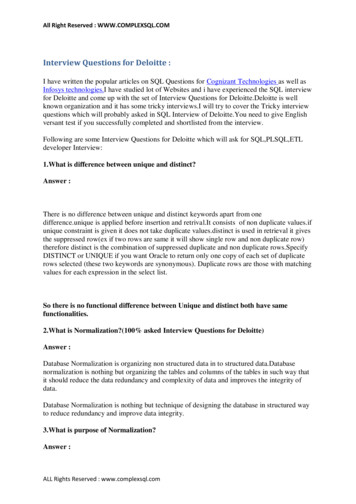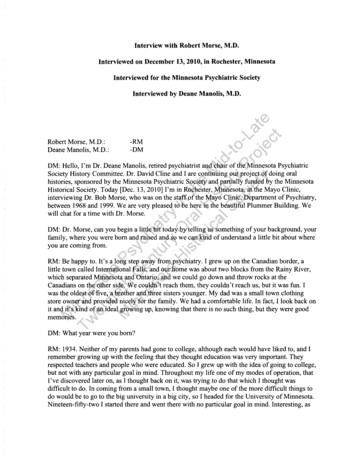
Transcription
Interview with Robert Morse, M.D.Interviewed on December 13,2010, in Rochester, MinnesotaInterviewed for the Minnesota Psychiatric SocietyMTw innen esotie taM th Psin C yne e chso ntu iata ry tryH O inis ra thto lric Hi e Mal sto idSo ry -toci Pr -Let o aty je ectInterviewed by Deane Manolis, M.D.Robert Morse, M.D.:Deane Manolis, M.D.:-RM-DMDM: Hello, I'm Dr. Deane Manolis, retired psychiatrist and chair of the Minnesota PsychiatricSociety History Committee. Dr. David Cline and I are continuing our project of doing oralhistories, sponsored by the Minnesota Psychiatric Society and partially funded by the MinnesotaHistorical Society. Today [Dec. 13,2010] I'm in Rochester, Minnesota, at the Mayo Clinic,interviewing Dr. Bob Morse, who was on the staff of the Mayo Clinic, Department of Psychiatry,between 1968 and 1999. We are very pleased to be here in the beautiful Plummer Building. Wewill chat for a time with Dr. Morse.DM: Dr. Morse, can you begin a little bit today by telling us something of your background, yourfamily, where you were born and raised and so we can kind of understand a little bit about whereyou are coming from.RM: Be happy to. It's a long step away from psychiatry. I grew up on the Canadian border, alittle town called International Falls, and our home was about two blocks from the Rainy River,which separated Minnesota and Ontario, and we could go down and throw rocks at theCanadians on the other side. We couldn't reach them, they couldn't reach us, but it was fun. Iwas the oldest of five, a brother and three sisters younger. My dad was a small town clothingstore owner and provided nicely for the family. We had a comfortable life. In fact, I look back onit and it's kind of an ideal growing up, knowing that there is no such thing, but they were goodmemOrIes.OM: What year were you born?RM: 1934. Neither of my parents had gone to college, although each would have liked to, and Iremember growing up with the feeling that they thought education was very important. Theyrespected teachers and people who were educated. So I grew up with the idea of going to college,but not with any particular goal in mind. Throughout my life one of my modes of operation, thatI've discovered later on, as I thought back on it, was trying to do that which I thought wasdifficult to do. In coming from a small town, I thought maybe one of the more difficult things todo would be to go to the big university in a big city, so I headed for the University of Minnesota.Nineteen-fifty-two I started there and went there with no particular goal in mind. Interesting, as
MiTw nnen esotie taM th Psin C yne e chso ntu iata ry tryH O inis ra thto lric Hi e Mal sto idSo ry -toci Pr -Let o aty je ectyou think back on your life how you have kind of serendipitous relationships that mold you, andI ended up with a psychology major because that was the area that I was particularly interestedin, but I was very naIve about it. My advisor was Dr. Richard Elliott, who was chair of thepsychology department. He was a very wise man who didn't see me very often, but when I wasabout a junior he said, Bob, what do you want to do with your degree? I mumbled somethingabout I'm not sure, but I'd like to help people with psychological problems. He said - this is veryinteresting now - This is about 1954 or '5. He said if that's what you want to do, maybe youshould consider medicine, because I think the future of mental illness will be more biological.You may need to have a medical degree. So here's a psychologist in the '50s pointing metowards medicine. I had never really thought of medicine, partly because I didn't like hardsciences. So I re-thought, got back into pre-med, struggled through zoology and chemistry andphysics [laughter] and finally went to med school, kind of with that background.DM: So you had to kind of catch up on some of those things.RM: Absolutely. It was not fun.DM: They used to talk about zoology as being the make or break for pre-meds.RM: It nearly broke me. [laughter] That was kind of the short story.OM: Were you affected by any of the drafts back then at that time?RM: After I finished med school, interned, we were under the Berry Plan remember that?DM: OK. We'll get to that later-I went through the Berry Plan, too. So you went straightthrough school?RM: Eight years.DM: Did you go to the University of Minnesota Medical School too?RM: Yes. Briefly, my personal life: My wife of 52 years now, is a lady - girl- that I grew upwith in International Falls. Her mother was my 4th Grade teacher, which was the year mymigraine headaches began, and I think that's coincidence only [laughter]. She is a pathfinder, abright lady with leadership qualities. She went to law school and back in those days, not manywomen did. When she passed the bar exam it was her and 160 men. We got married when shewas in law school and I was in med school and struggled the way a lot of students do. Sheeventually became a judge in Rochester and for the last sixteen years of her career was a districtjudge. So we had an interesting long-range relationship.DM: So she was a judge here?RM: Yes. In Rochester, yes.DM: So you were married when you were in medical school?2
RM: Yeah.OM: As I recall, I was a couple of years behind you in medical school and so you were in theclass of '60?RM: ' 60, yeah.MiTw nnen esotie taM th Psin C yne e chso ntu iata ry tryH O inis ra thto lric Hi e Mal sto idSo ry -toci Pr -Let o aty je ectOM: I would have been just a year behind you, initially. I was out for a year because I had TB,so .RM: Oh you did? I didn't know that.DM: That was the time when there was a very strong psychiatric faculty at the U. Any thoughtsabout how you gravitated to psychiatry then?RM: Well, it's interesting, because I told you about my psychology background. Once I get intomed school and had struggled through the sciences, I get turned on by the sciences in the firsttwo years ofmed school. I did fairly well, studied hard, but you know we had the chemistry,physiology, anatomy stuff, and I began to think psychiatry was not very scientific, not scientificenough. So I drifted away. Then, decided to take a psychiatric fellowship one summer out at theVA with Werner Simon. Remember Werner?OM: Yeah.RM: Good man. And [Orville] Henry Johnson?OM: OK, yeah.RM: They were - in fact all of the psychiatrists I met in med school were solid people. I thinkthey were all good role models. That got me thinking more about it, but I frankly was a littlenervous about the psychoanalytic leanings and didn't really agree with some of it, thought someof the people that went into the field - not at Minnesota, but otherwise - were a little strange, andthat kind of pushed me away. So as I went to my general rotating internship out in California, Iwas thinking general practice. And then that's where the Berry Plan came in, which allowed us,as you know, to choose when we wanted to go into the service.So, I went into the Air Force, got my first taste of government decision-making. [laughter] Mywife and I had always wanted to go to New England. They said you could request where youwanted to be stationed, so I requested New England, so we went to southern California. Classic.So I spent two years at March Air Force Base, as a general physician. Delivered 200 babies,liked that, did all kinds of stuff, and I was kind of set to go into general practice. I had somefriends there that had invited me, but something kind of held me back. I still had this psychiatrything in my mind. So, at that time, I don't know if you recall, psychosomatic medicine was thebuzzword, and I thought maybe that's what I ought to do, so I went back to talk to one of our here's another bit of advice, like Elliott's, that was life changing. I went to see Dr. Dick Magraw,3
who was the dean of our med school, or assistant dean. He was boarded in psychiatry andmedicine, and I told him what I was interested in. He said, if that's your interest - and this is theguy at Minnesota - maybe you ought to consider going to the Mayo Clinic for your training,because they are more medically oriented than we are. And then if you want to transition intomedicine from there, it might be easier. Well, that's what I did, and, as they say, that was thebeginning of my career here.DM: So that was as you were finishing your military service.MTw innen esotie taM th Psin C yne e chso ntu iata ry tryH O inis ra thto lric Hi e Mal sto idSo ry -toci Pr -Let o aty je ectRM: . finishing my military.DM: And you went back to see Dick Magraw?RM: I came back to talk to him about what shall I do. These are my interests.DM: Dick is one of the first people we interviewed for this new series, so we've got him.RM: Is he still around?OM: Oh yeah. I saw him about a month ago. He's 91. He's doing very well.RM: I have thanked him in the past for just what we're talking about, pushing me in the rightdirection. I came down here for psychiatry.OM: What year did you start the residency?RM: That was '63 to '66, and -loved it. Loved it almost from the very beginning. So I wasconvinced I was in the right field. I think it was partly that we were surrounded by regularphysicians everywhere we went here. So, it wasn't like you were in a psychiatric institute, forexample, that was apart from medicine. So that was all attractive to me. And then I had, becausewe had two children, I had taken my residency as a fellowship, sponsored by the State ofMinnesota, which paid my salary, but lowed them two years of my life after that. I was kind ofdisappointed because, although I'd never thought about kind of an academic career, I gotinterested in it at the Mayo Clinic. I thought maybe I had a chance to stay on here, but had to gowork for the state. Again, as luck would have it, the mental health center in Rochester's solepsychiatrist decided to move back to his home area in Oregon, left an opening, which I took. So Iremained here and Ed Litin, who was head of our department at that time, was on the Board ofthe mental health center, and Ed recruited me, eventually, back to join the staff here, so that allworked out well. But, as you know, my subspecialty interest was addictions and alcoholism, andagain, like most of my story here, I had no idea I was going in that direction. At the mentalhealth center, at that time, it was '66 to '68, there is some interest in the country and inMinnesota in alcoholism. And the Board said, Morse, why don't you start an alcoholism programhere, and through the community psychiatrists.OM: At the mental health center?4
MTw innen esotie taM th Psin C yne e chso ntu iata ry tryH O inis ra thto lric Hi e Mal sto idSo ry -toci Pr -Let o aty je ectRM: Right here. And I could have cared less, because I had kind of traditional medical trainingin alcoholism, which didn't make it sound very attractive. But anyway, we did, and I had twoalcoholism counselors who were both recovering people that worked for the mental health centerthey were helping me. They loved to tell us young psychiatrists what this was all about, and, ofcourse, with my traditional training, I really didn't know what it was all about. We started theprogram and had some interesting experiences; for example, sending a patient to Willmar StateHospital [Minnesota's state alcohol treatment program] against his will, and he came back amonth later and thanked me for sending me [sic] against his will. That was the beginning ofunderstanding that alcoholics and addicts have little or no insight into their problem and if you'regoing to treat them they have to be coerced in some way to get into the program. It all kind ofbecame fascinating to me, and partly because no one in Rochester in the medical communityseemed to be interested.DM: As I look back to the history of the Clinic, there was, as I recall, at that time, there was evensome antipathy on the part of general medicine toward patients with alcohol issues.RM: Oh yeah. At St. Mary's [Rochester] hospital there was an unwritten rule that an alcoholichad to be hospitalized on the closed psychiatric ward, so if you had anybody that you'd labeledalcoholic, they were transferred up to the closed ward. I think the idea was they were going tohave DTs or be disruptive, or something-very unenlightened. But the other thing that wasfascinating to me was that as I got experience with these people, and somehow I had theconfidence that what I was learning - even though it was opposed to what I was taught - wasmore accurate, because I was learning it from patients. That this [alcohol dependency], ratherthan being a disorder that was symptomatic of some underlying problem, somehow became aprimary disorder, sooner or later, so that it didn't make much sense to hunt around for whatstarted it. That you had to start with the addiction, and there were things you could do there thatpeople like the Hazelden program, AA even, had taught us; and that was both exciting andworrisome, because when I came back to Mayo [in 1968] and talked about it - you know, off andon I was still consulting to the mental health center.Finally, Dick Steinhilber, who was head of our department then, said, Morse, if you are going totalk about this all the time, dammit, let's do something about it. So he gave me a green light tostart a program. Well, to start a program at that time - well, even now - implied that we had toshift gears and approach it differently than psychiatry was, as you know. I wasn't sure that wecould do that, because it was a little bit like swimming upstream, but I think, to the credit of ourdepartment, they were open-minded enough to say as long as you are going to do it, Morse, yougo ahead.My only virtue at that time was that I was willing to listen to other people, and I had a lot ofquestions. So we traveled around, went up and talked to Dan Anderson at Hazelden [one of theearliest and largest of the Minnesota programs, in suburban St. Paul], Vern Johnson at theJohnson Institute [of Minneapolis], Phil Hanson at Northwestern [Minneapolis], Dick Heilman[MD] at the VA [Minneapolis]DM: He [Heilman] was a residency mate of mine.5
RM: Was he? OK. Good guy.MTw innen esotie taM th Psin C yne e chso ntu iata ry tryH O inis ra thto lric Hi e Mal sto idSo ry -toci Pr -Let o aty je ectIn Georgia, the Georgian Clinic at that time was thought to be a good program, so I went downthere, too. I kind of decided the model we wanted to set up, recruited a nursing staff, hired acouple counselors, tried to kind of get them molded, and then in 1972 we opened a 22-bed unit.This was one of those shaky times. The friends that I had begun to know in alcoholism - I wentto a few national meetings and got to know some people - they all said, well, Bob, within amonth you are going to be overwhelmed with patients. We opened the doors. A year later wewere 50 percent occupancy, and I was scratching my head and wondering what was I doingwrong. What were we doing wrong? I think it was a combination of things. We hadn't done the[medical] staff education that we should have, probably, ahead of time, but we had such a smallcovey of people that it was hard to take care of patients and do everything. The stigma was stillthere in organized medicine, and we were kind of the epitome of organized medicine.OM: We don't have alcoholics at Mayo. [laughter]RM: That's right. In fact, we did an interesting study to estimate what kind of demand we wouldhave. We went through records for a year at Mayo, around that time, to document how manycases of "alcoholism" were seen at the Mayo Clinic. You won't believe this, but it came out to0.6 percent of the patients. Well, you know that at least 10 percent of the general population arealcoholic. People that come to a medical center probably doubles that, but only six tenths of onepercent of our patients were getting that diagnosis, which meant that nobody was calling it as itwas. They either didn't want to diagnose it or they were missing it. So, that's kind of theatmosphere that we started out in. But it worked out. We had to be patient, and after the first yearwe became filled and popular.OM: Did you do some staff education then?RM: Yeah. We tried to get on grand rounds and some of the . there were a lot of conferencesgoing on, and we tried to do that. We had some help from a couple of well-respected internists atMayo. Dr. Rollie Dixon and Dr. John Higgins both were in GI, and they both had an interest inhelping us get started, and I think that helped pave the way, because they would do some of ourmedical exams and were well thought of by the staff, otherwise. So that was how we gotunderway. The model that we tried to develop - did develop - was the Minnesota Model, whichwas kind of The Model in the country at the time. It came out of Willmar State Hospital and alsoHazelden, which was essentially staffed by recovering alcoholic counselors, nurses. [They] havean educational program, have group therapies, introduce AA. The thing we wanted to dodifferently, since we were in a big medical center, is to see if we could integrate generalmedicine with it. From the beginning each of our patients had a psychiatric exam. The unit wassupervised by a staff psychiatrist. It started out with me, and then we had some other people. Wehad these two residents with us in training, so from the very beginning we were hooked up withthe training program in psychiatry, and it became required of psychiatrists trained at Mayo thatthey have this experience, which we were very happy with.OM: So that became a part of the requirement of the residency program?6
RM: Yeah. And the model that we used was to have the counselor and the resident run thegroups. We had no idea how that was going to turn out but it was a blessing in disguise, becausethey helped each other. The resident kind of learned the dynamics of alcoholism by sitting withthe counselor in two groups a day, and the counselors kind of leaned on the residents for helpwith difficult patients and stuff like that. So it became kind of the teaching module that we used.And we began to try to treat psychiatric problems at the same time, and this was kind of a no-noin the established field.MTw innen esotie taM th Psin C yne e chso ntu iata ry tryH O inis ra thto lric Hi e Mal sto idSo ry -toci Pr -Let o aty je ectDM: The old counselors and AA really mistrusted psychiatry.RM: They did. They would typically, if you had a psychiatric disorder, you were either treatedfor alcoholism and that was ignored, or they suggested you go see a psychiatrist and then comeback for your treatment, but don't do them together. So that was our challenge, and we were ableto do it up to a point with non-psychotic patients. You could treat a major depression in atreatment program where the patient was being treated for alcoholism. You could treat anxietysymptoms, personality disorders, it kind of all came out in group therapy anyway. So, in someways we thought it was kind of a natural thing to do.And then, to our pleasant surprise, we did some after-care studies and, following the patients fora year afterwards, the recovery rates, looking at no more than one slip, no return to addictivebehavior, about two-thirds of our patients were doing well, and the patients with psychiatricdisorders were doing as well as the others. So it looked like you were able to do that. Also, withmedical problems. As you know, the traditional programs didn't want you to be treated fordiabetes or something else at the same time. But we were able to do some of that, too. So, wethought we had a nice way to approach it, and I still think it's maybe the ideal way to do it, but itbecame too expensive. In fact, everything we did became too expensive after awhile, after we gotthrough kind of the golden years of the '70s and early '80s. Managed care began to shut downthe door to bringing people in.DM: You had the classic 28-day inpatient?RM: We did start out with that.DM: And then they gradually reduced payment?RM: Yeah. So we did what everyone else was trying to do. We didn't have an outpatientprogram to start out with because we didn't have enough people to run it. But, we developed anoutpatient program, and we developed a partial hospitalization program. The interesting side ofthe managed care thing is that they were not true to their word, in my opinion. The people wehad talked to about this, as it was coming in, said, well, there are people that don't have to be inthe hospital for 28 days. We said, well, we can agree with that. There are some that couldprobably be handled in a shorter stay or outpatient, but there are a large number that needresidential care, and some even more than 28 days. The managed care people said yes, thatcertainly would be available. Well, not only was it never available, but we never got approval foranybody up to 28 days after they started this. So, I think we were sold a bill of goods. And, asyou know, many of the programs kind of wound down. Some had to close. We went to a mostly7
partial hospitalization program. And, of course, our model, the medical model, was very difficultto maintain, as in less than residential, because you can't look at all these things we were tryingto look at as people were coming and going. So that was the disappointing side.DM: When did that happen, do you think, looking back?RM: I think of the' 70s and maybe the first half of the '80s as being kind of good years. I wouldthink around the mid-' 80s. I'm not sure.MiTw nnen esotie taM th Psin C yne e chso ntu iata ry tryH O inis ra thto lric Hi e Mal sto idSo ry -toci Pr -Let o aty je ectA lot of fun connected with it, and in fact as I look back on my career at Mayo, I couldn't havebeen anywhere that I would have been more happy. Did what I wanted to do. I was mostly aclinician, but I taught, I did some research, I did some administration, and for the most partnobody looked over my shoulder and told me what I had to do, so it was very nice.We had a couple of interesting features of our program. Because we were a referral center andpeople come from elsewhere, we decided we would have a reunion once a year and invite themback and try to put on a nice program for them. We would have an educational session in themorning and afternoon, then a banquet and then we would bring in a featured speaker. We hadsome interesting people, like Don Shelby, who just retired from WCCO-he came down oneyear. I'm blocking on some of the others, but that was the fun thing to do. Then, education-wise,one of our staff, Mary Martin, was a social worker, who worked with us. She had an artistic flairand knew some people on Broadway, etc. Well, long story short, she convinced Jason Robards,the famous actor, to come as a staff education program, and to do the soliloquy from The IceMan Cometh, which was one of Eugene O'Neill's plays about an alcoholic. So he did that for ourstaff education meeting. We had a thousand people at this. That was the biggest program thatwe'd had down here. After his performance, several of us, including Dan Anderson fromHazelden, Bob Nevin, who was a psychiatrist with us-later went on to become head of NationalInstitutes of Alcoholism-Anyway, they did some brief didactic stuff and then we had questionsand answers from the audience and it was a lot of fun.DM: You did that for some years?RM: We did that two or three times with Robards, and then we did it with a couple other actors,too, that I'm blocking on. But that was an interesting flair.DM: I'm sure Hazelden attracted people from all over the country and probably from all over theworld, didn't they? Did you get some overflow from that, or did you have your own referral basejust built in here?RM: Most of our people were like the Mayo Clinic in general, which is that about half of ourpatients come from kind of this region, and then a scattering around the country, including othercountries and whatever. We got some selected celebrities, and I had to learn to deal with that. Ithink our first bona fide cocaine addict was a Hollywood producer who came in with her fur coaton and wouldn't take it off for four days because it was too cold in Minnesota. [laughter]8
We didn't quite get to where we wanted to with Hazelden. Dan Anderson and I were goodfriends and we had talked off and on about - they had some things we didn't have, like abeautiful campus and long-term treatment and that kind ofthing. We had some things that theydidn't have, like medical and psychiatric facilities, and we thought about maybe we should havea coordinated treatment approach, but we never quite got there. But they would send us patientsat times and we would send them patients.MTw innen esotie taM th Psin C yne e chso ntu iata ry tryH O inis ra thto lric Hi e Mal sto idSo ry -toci Pr -Let o aty je ectAnother interesting thing we did was the impaired physician programs. Impairment at that timeusually meant being addicted as a physician, and partly because we were a Mayo Clinic program,partly because Mayo Clinic is not known as an addiction treatment center, we got a lot ofphysicians coming in. Partly, they could always tell people at home they went to the Mayo Clinicfor treatment for something. So we took an interest in that and then got hooked up with someprograms around the country. I don't know if you knew Jim West? He was head of the impairedphysician program in the State of Illinois. They sent us a lot of people. Jim eventually went to theBetty Ford Center [California] and became medical director out there. We treated the physiciansessentially the same way we did with everybody. We wrote a paper describing the outcome,which showed that the physicians as a group did better with the same amount of treatment as thegeneral patient. We thought one of the reasons for that is they got monitored after they got out.They went back to their group or hospital or whatever and they had to toe the line, submit urinesfor analysis.DM: Did you have separate groups for the docs or were the others all integrated together?RM: No, we did not. We tried to focus on their needs, which were different, but not in separategroups. I think that was probably therapeutic for them.DM: When Mayo spun off Scottsdale and Jacksonville, did you have programs started out inthose places as well?RM: Did not. We had people that were in psychiatry in each place that talked as though theywanted to do this, but nothing got underway. As far as I know, they don't have anything formal.DM: We were talking earlier about the fact that psychiatry didn't have a real home within theClinic, and so that extended to your program as well? You had to move around?RM: We did. We started in what's called the Colonial Building, which was actually apart fromthe two basic hospitals - It was formally a part of the Methodist Hospital but it was a separateold building on the side, and we had our 22-bed unit there for ten years. Then they moved us to9th Floor of the Methodist Hospital for another ten years, and by that time, through a lot of effortand discussion, the Generose Building was built as a separate hospital adjacent to Saint Mary'sand was dedicated to psychiatry. So we became part of that.DM: You had a space at the Generose Building?RM: Yeah. But we bussed around for quite awhile. We actually thought we were better off in themidst of a medical hospital because people had to see us then. They didn't have to go to the9
psychiatric building to see where we were, and we thought that maybe we did more educationthat way, but we have a nice place now at Generose.OM: This is a side issue, too, that where I practiced in general hospitals, where we had apsychiatric unit, and that helped us maintain the medical end of things as well. Did you feel onceyou were in the Generose Building that you got out of the mainstream of medicine, somewhat?MTw innen esotie taM th Psin C yne e chso ntu iata ry tryH O inis ra thto lric Hi e Mal sto idSo ry -toci Pr -Let o aty je ectRM: Good question. In some ways we did, because we had to bring the . well, the way we ranour psychiatric unit, I guess is the way a lot of people do. Your medical exams were done byyour residents, who were usually psych residents, and then to get general medicine involved tooksome doing. You had to have a complicated problem or something, and we did kind of get out ofthe mainstream there. So, you win some, you lose some.OM: Your entire career at Mayo was in addiction?RM: Addiction, although like all Mayo physicians or Mayo psychiatrists at that time, we all didwhat were called consultations. We called them off-the-floor consultations, which meant that youleft your floor in the Mayo Building and went to somebody else's floor. Usually we'd do four ina day's time.OM: These were outpatients?RM: These were all outpatients, so it would be coming to surgery or medicine or something andthe physician who saw them there requested a psychiatric exam. We'd go up, actually talk to thephysician - which was the fun part of it, 'cause you get to know a lot of people that way - andwent in, did a one-shot consultation with the patient, tried to arrive at a diagnosis, problem,disposition, or do we need to work it up further. I did that all through my career, too, which Ienjoyed.DM: Would you have an hour-long interview? Were you able to have an hour with the patient?RM: Yeah, at that time. That was before electronic records, so you could scribble all over[laughter] . Nobody could read [the chart]. I remember that.OM: So that kind of kept you in the mainstream of psychiatry, as well.RM: In the mainstream, yeah.OM: Thinking back about some of the leaders of your department at Mayo, some of the peoplethat we hear about so much from the past, do you have any recollections about any of thosepeople, like Howard Rome?RM: I got to know Howard and Ed Litin pretty well. David Boyd, who was another name in ourdepartment, I didn't know him very well, but as I mentioned, Ed Litin was head of thedepartment when I joined.
Dr. David Cline and I are continuing our project of doing oral histories, sponsored by the Minnesota Psychiatric Society and partially funded by the Minnesota Historical Society. Today [Dec. 13,2010] I'm in Rochester, Minnesota, at the Mayo Clinic, interviewing Dr. Bob Morse, who was on the staff of the Mayo Clinic, Department of Psychiatry,
